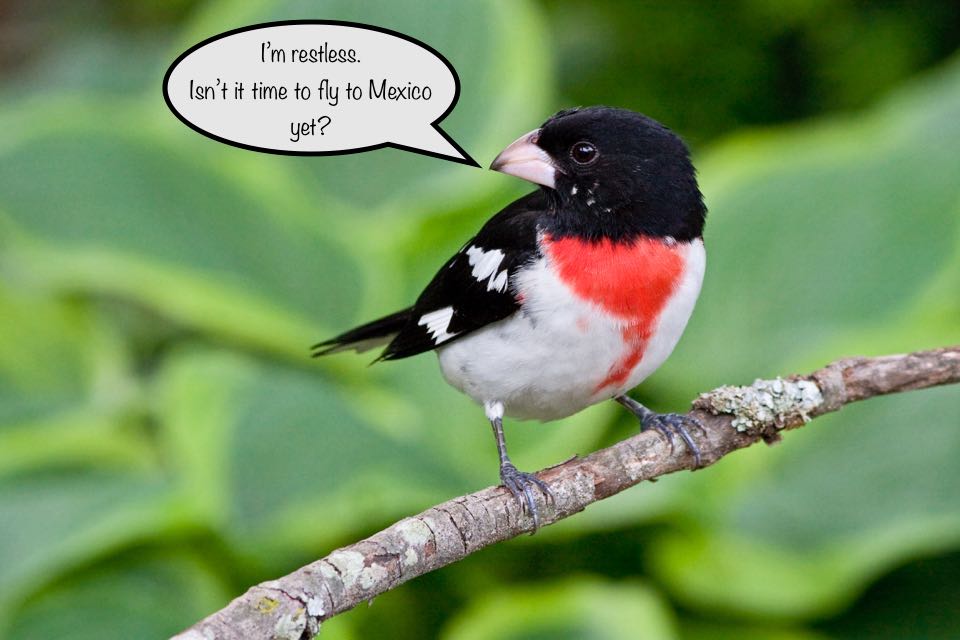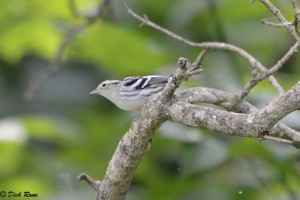By Ashley Peele

Rose-breasted Grosbeak (Bob Schamerhorn)
Atlas Birding in Late Summer…
As we slowly roll into the Fall migration season, we need to start using a little more care when applying breeding codes to our observations. As migrants begin moving back through Virginia, it’s a good idea to consult the Breeding Timeline Charts to see what species have entered the transition zone (when northern breeders begin mixing with our local summer residents). Here are a few questions to ask yourself during your late summer birding…
- Can I be sure this juvenile bird was hatched in my block? This question is much more difficult to answer at this time of year. Many juveniles are now dispersing out and away from their natal areas, so it is possible that you’ll have new juveniles moving into your block. One way to gauge a local fledgling is to look at tail length. Recently fledged young tend to have shorter tails than juveniles fledged earlier in the season. In general, its best to err on the side of caution at this time of year. If you’re not sure, get a second opinion from your regional coordinator or birder friends.

Black and White Warbler (Dick Rowe)
- Example 1: A fuzzy juvenile Cedar Waxwing begging for food in your pine trees is still a solid FL code in August.
- Example 2: The juvenile Black and White Warbler foraging independently on the edge of the woods is NOT a reliable FL code. In fact, this bird should get no code at all.
- Is it possible this bird is migrating? If yes, then do not use the H or S codes. Most possible and probable codes no longer apply to species that may be passage migrants. In fact, it’s best to only enter confirmed codes for potential migrants at this point in the season. For resident species, a few may still be in active breeding mode. American Goldfinch are notably late breeders may still be on eggs, have nestlings, or recently fledged young. However, most species should not be defaulted to H or S anymore.
- Example 1: Eastern Wood-Pewee singing in the woods – this species is well into the ‘transition’ time, so singing individuals could be passage migrants. S code no longer applies.
- Example 2: Green Heron sitting near a pond – again, well into the transition time, so H code is out!
- What confirmed codes are still useful? There are several codes that are safe to use, even this late in the breeding season. These include FY (feeding young), NE (nest with eggs), and NY (nest with young). However, it is unlikely that any of our migratory species will still be exhibiting these behaviors. If they are, DEFINITELY report this to the Atlas. Such observations are important for improving our knowledge of breeding phenology in VA.

Red-bellied Woodpecker Feeding Young (Bob Schamerhorn)
- Should dates on the breeding timeline chart override my own observations? No! These charts are meant to illustrate the available information on timing of breeding and migration for species breeding in Virginia. However, your observations take precedence over these guidelines. We are always looking to refine these charts for each region of Virginia and your observations can help us do this. Just remember to follow the precautions described above.
- Do I have any breeding codes on my checklist? If the answer is no, then submit that list to good old-fashioned eBird (ebird.org), instead of the Atlas eBird portal. This prevents us from having to weed those out of the 14,000 or so checklists from this year. Remember, the time for switching portals has arrived again!

Cedar Waxwing (Ashley Peele)
Late summer birding can still produce breeding evidence for late-breeding species (Golden-crowned Kinglet, Cedar Waxwing, American Goldfinch) or resident species that breed into early Fall (Carolina Wren, Mourning Dove, and Northern Cardinal). Just remember to keep the possibility of migrants and post-breeding dispersal (pesky roaming juveniles) in mind!
Thanks for all your continued hard work and when in doubt, ask questions!
~Dr. Ashley Peele, VABBA2 State Coordinator

